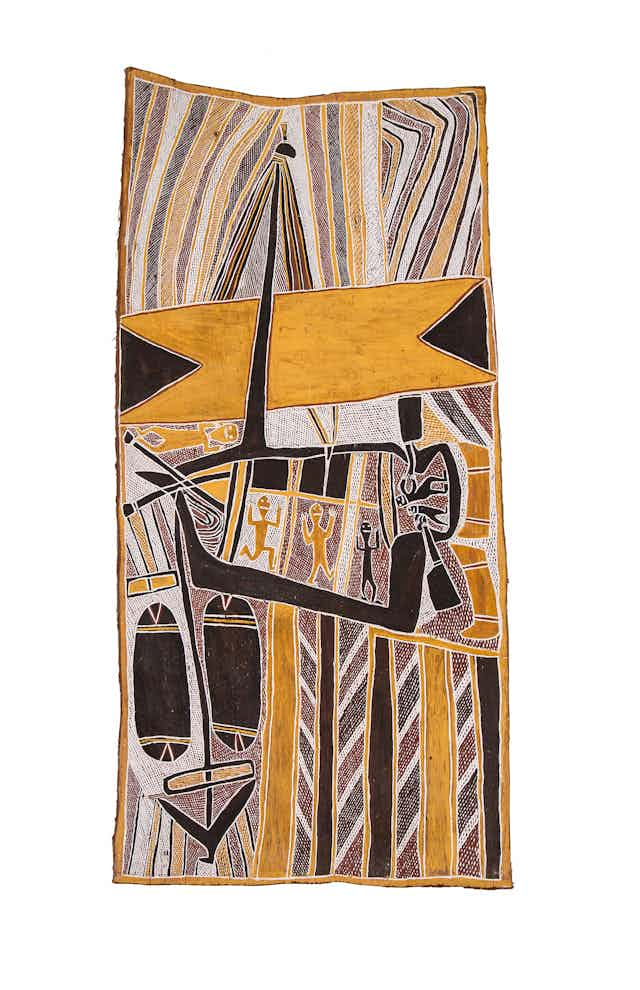As part of the celebrations to mark the 400th anniversary of Dutch explorer Dirk Hartog “bumping” into the north-west coast of Australia, Travellers and Traders in the Indian Ocean World charts the ebb and flow of people, goods, stories and ideas across the expanse of the Indian Ocean.
The oldest object included is a 2500BC clay boat that presages the journeys undertaken over the following millennia with the aid of the Roaring Forties and the annual monsoons.

It was the reliability of these winds that enabled regular journeys, and it was on Australian beaches that the first point of contact with Aboriginal Australians and those from other continents began. Earlier than the Dutch, the English, and the French, the Macassan fishing fleets regularly visited Arnhem Land and the North West coast in search of trepang (the sea cucumber).
Their visits were recorded orally for centuries. Two mid-20th century bark paintings from Yirrkala depict these stories, showing praus (fishing boats) under full sail. Departing from the southwest Celebes (now Sulawesi, Indonesia), the Macassans made landfall in Arnhem Land and exchanged goods and cultural information before moving westward down the coast in search of this rare delicacy.
Their distinctive sails puncturing the sky, the praus described in these paintings would have been impressive as they arrived off the coast. With men below decks and others attending to the twin rudders and chickens running wild on the decks, these images of the boats record details of their design and operation based on cozy familiarity.
Their regular return trips indicate that the local communities welcomed their visitors, and when they dropped anchor to prepare for their long stay, the festivities began.

Once they had caught substantial numbers the trepang were boiled, dried and processed on the beaches, under Tamarind trees the visitors planted. As anthropologists Ronald and Catherine Berndt explain, these visits are remembered through generations in oral histories, songs, dance and in rock paintings and bark paintings, like those in the exhibition.
To communicate with their visitors the Yolŋu community adopted a Macassan Pidgin, with some words still in use, such as “rupiah” for money, “balanda” for white person and “jama” for work. They also exchanged goods and it is likely that some of the Aboriginal men worked with the trepangers on their praus.
A few would have returned to Port of Macassar where they encountered Dutchmen, like the one depicted in the wonderful sculpture collected by Ronald and Catherine Berndt in Yirrkala in 1946. This balanda (European) man, with his jaunty cap, radiant grin and elaborate buckled belt, was likely a customs official who made a distinct impression.

Later, Mungurrawuy Yunipingu carved and painted his version of a meeting that likely took place many decades before, reinterpreting their detailed descriptions to create his lively portrait.
Called Waramu figures, these sculptural works collectively represent the visiting Macassans, and they are similar to the carved wooden effigies, called Tau tau, made by the Toraja people of South Sulawesi as part of their burial ceremonies. It is likely these carved figures were another aspect of a rich exchange of culture and ideas.
This long history of engagement between the Yolŋu and their northern neighbours remains embedded in their culture and in stories still recounted. Indeed, the tradition of Yolŋu painting on Torajan pots is one currently being revived. Will Stubbs from the Buku-Larrnggay Mulka Centre is developing a project to commission the building of a traditional Prau in Sulawesi and then sail it to Port Bradshaw where it can become the catalyst for rekindling this unique form of cultural exchange.
Neil MacGregor’s tried and true format of judiciously selecting a limited range of artworks and objects to tell a big story has been embraced by the Western Australian Museum and the British Museum for their latest collaboration. How else could you even attempt to encapsulate the complexity of contact over thousands of years of constant exchange between many different cultures and communities?
MacGregor’s exhibition Shakespeare’s Restless World and his marvellous Germany, Memories of a Nation, not to mention the international blockbuster A History of the World in 100 Objects, enabled him to tackle subjects that might otherwise have been uncontainable.
Similarly, Travellers and Traders, which only ripples the surface of this vast subject, provides enough to intrigue, to entertain and, most importantly, to stimulate further investigation.
The story of the Macassan traders is one of many interweaving narratives that run through the exhibition. By piquing our interest, it challenges us all to dig deeper and find the links that unite us across the expansive arena of the Indian Ocean.
Travellers and Traders in the Indian Ocean World is at Fremantle Maritime Museum until 23 April 2017.

